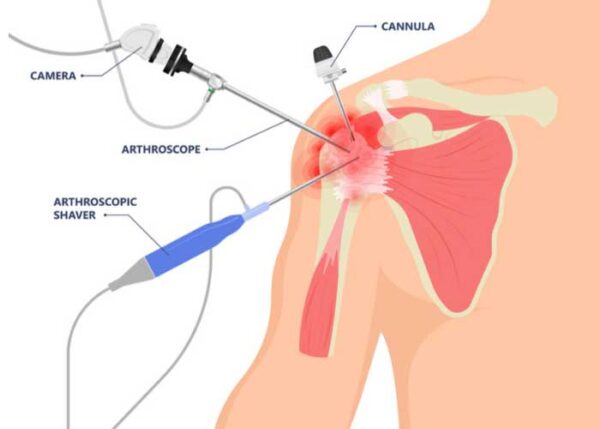Rotator Cuff Repair Doctor

Athletes or individuals who participate in activities that involve throwing or lifting overhead are at risk of developing a rotator cuff injury. The rotator cuff can become damaged from sports, degeneration, or from trauma. If you have injured your rotator cuff, rotator cuff surgeon, Doctor Riley J. Williams provides diagnosis as well as surgical and nonsurgical treatment options for patients in Manhattan, Brooklyn, New York City and surrounding areas who have sustained a rotator cuff injury. Contact Dr. Williams’ team today!
What is a rotator cuff repair?
The rotator cuff is the group of muscles and tendons that immediately surround the shoulder joint. These four muscle-tendon groups originate from the scapula (shoulder blade) and attach to the ball of the humerus (upper arm bone). These muscles and tendons are responsible for providing shoulder stability and active shoulder motion. Damage to the rotator cuff can result from a sports-related injury, a fall on an outstretched hand, or tearing associated with age related tendon degeneration. Rotator cuff injuries range from inflammation (tendonitis), partial tears, or complete severing of the tendons from their attachment site on the humerus. Surgical repair of the rotator cuff is very effective at relieving pain and dysfunction; surgery is most often needed in the cases of recalcitrant inflammation associated with partial tears and complete rotator cuff tears. Dr. Riley J. Williams, orthopedic shoulder surgeon, treats patients in Manhattan, Brooklyn, New York City, NY and surrounding areas who need a surgical rotator cuff repair.

How is a rotator cuff repair performed?
Currently rotator cuff repair is an arthroscopic, minimally invasive procedure. A small camera is inserted into the shoulder joint, and special surgical instruments are used to reattach the severed tendon back to the head of the humerus. In most cases, patients are gently sedated and a nerve block is applied to the injured shoulder to facilitate execution of the repair. Partial rotator cuff tears are usually treated with debridement, a procedure that removes the torn or frayed portions of the rotator cuff tendons. Care is taken to create functional space for the rotator cuff to function; excess bursal tissue and bone spurs are often removed in these cirucmstances as well. In cases of complete rotator cuff tears, the tendon is sutured back to the head of the humerus using special surgical anchors that are deployed within the bone of the native insertion site of the tendon. It is imperative for proper healing that the tendons are fastened to their correct anatomical position. Dr. Williams achieves this through an innovative surgical technique known as a double-row arthroscopic rotator cuff repair. Studies have shown that a double row of sutures provides extra stability to severely torn tendons, as well as a significant reduction of another tear with increased stress to the repaired tendon. The arthroscopic approach to rotator cuff repair facilitates an exacting, detailed oriented repair based on full visualization of the affected tissue.
How long will the rotator cuff repair take?
Dr. Williams will review the patient’s medical history, physical examination, and diagnostic imaging to determine the type of tear and damage sustained to the rotator cuff. The time for this procedure is dependent on the complexity of the injury, the extent of the tear, and if any other revisions will need to be completed. In most cases, the procedure will take approximately 60 minutes.
What are the risks and benefits of rotator cuff surgery?
Dr. Williams prefers the arthroscopic approach to a rotator cuff repair because it is less invasive and precise. Due to the size of the camera and specialized surgical instruments, the incisions are small and allow for a faster recovery time for the patient. Arthroscopic rotator cuff repair also offers less blood loss, less chance of infection and less pain.
What is the recovery period like after rotator cuff repair surgery?
The recovery period varies among patients as it is dependent upon the severity and complexity of the rotator cuff repair procedure; however, most patients can expect to be fully recovered in 4-6 months. Range of motion, strength, and function all improve steadily over the year after a successful rotator cuff repair. In general, patients in New York can expect the following:
- A sling will be placed on the affected arm immediately after surgery. This is to ensure the shoulder joint is immobilized for proper healing of the repaired tendons. Typically slings are used for 1-2 weeks. Dr. Williams encourages patients to start moving their shoulder following rotator cuff repair as soon as possible.
- Passive range of motion exercises can be expected to begin the day after surgery. These exercises establish movement of the shoulder.
- Once proper healing of the repaired tendon has been ensured, active range of motion exercises can begin.
- Dr. Williams will recommend an appropriate physical rehabilitation program. Physical therapy starts 7-10 days following surgery. By adhering and successfully completing a physical rehabilitation program is the key to patient success following a rotator cuff repair.
For more information on rotator cuff repair, or to discuss your torn rotator cuff options, please contact the office of Riley J. Williams, MD, orthopedic shoulder surgeon serving Manhattan, Brooklyn, New York City, NY and surrounding areas.
